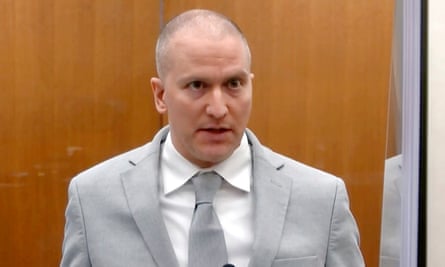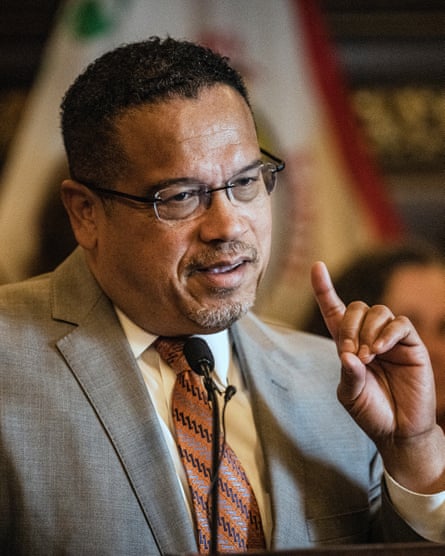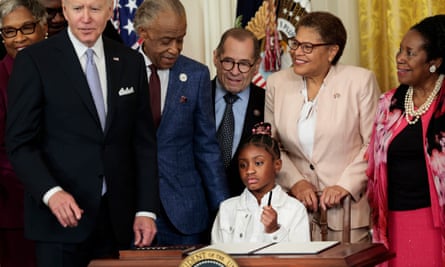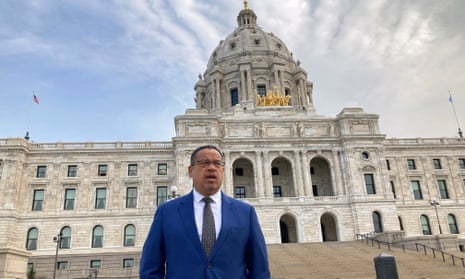When he recalls seeing Derek Chauvin in court for the first time, Keith Ellison references “the banality of evil”, a phrase coined by writer and philosopher Hannah Arendt when covering the trial of Adolf Eichmann, one of the architects of the Holocaust.
“The point of the whole book is that Nazis were not these big, scary people that your imagination conjures,” Ellison, Minnesota’s top law enforcement official, says in a phone interview. “They’re ordinary, they’re plain, they’re very regular and they’re a lot less than you assume they would be and that’s how I felt about Derek Chauvin. He looked like a relatively small man – I bet he didn’t weigh 140lb. Here’s this guy who acted so monstrously: it’s just a man, not a very big one.”
Chauvin, a white former police officer, was found guilty of murdering George Floyd, a 46-year-old African American man in Minneapolis, after kneeling on his neck for nine minutes. He was sentenced to 22 and a half years in prison and has appealed his conviction.
The prosecution was directed by Ellison, who led every meeting, assigned duties to the team and sat in court every day scribbling observations in old notebooks from his 12-year spell in the House of Representatives (he was the first Muslim elected to Congress). When those were full, a friend at a law firm gave him more.
The notes were invaluable to prosecutors as the trial unfolded and served as raw material for Ellison’s recently published book, Break the Wheel: Ending the Cycle of Police Violence, which offers a blow-by-blow account of the case and spotlights a culture in which the training manual often receives lip service and complaints about “bad cops” are too easily ignored. It asks what role prosecutors, defendants, heads of police unions, judges, activists, legislators, politicians and media figures can play in reforming a criminal justice system that fails people of color.
The book begins on the day three years ago last week when Ellison, attorney general of Minnesota, was woken by his phone at 4.45am by an urgent message. He watched a mobile phone video that showed Floyd, trapped under Chauvin’s knee, shouting “Mamma! Mamma! I’m through!” and, repeatedly, “I can’t breathe!” Ellison could not believe how long the torment continued.
The 59-year-old recalls: “Even though I have been working on police accountability and brutality issues for years, I was still shocked. I was still blown away by the inhumanity of what I saw.”
The side of every police car in Minneapolis displays the words: “To protect with courage, to serve with compassion.” The first statement from the city police department about Floyd was entitled “Man Dies After Medical Incident During Police Interaction” and made no mention of officers restraining him on the ground with a knee on his neck.

The state attorney general comments: “I did not expect to see basically a whitewashing of what happened to George Floyd. It said he died of a medical emergency – sounds like a heart attack or a stroke. It does not sound like positional asphyxia with a knee on the neck and so I found that dumbfounding as well.”
With America already traumatised by the coronavirus pandemic and Donald Trump’s divisive presidency in the summer of 2020, the killing ignited protests against police brutality and racial injustice. Ellison had expected the conscience of Minneapolis to be shocked but was not prepared for the demonstrations that took hold everywhere from Bogotá to Lisbon.
“In cities all over the world you saw an outrage. When I thought about it, I understood it because nowhere in the world do people tolerate arbitrary government force. They always protest it no matter what.”
America began a racial reckoning but, Ellison notes, around the world the issue transcended race. “In America everything is racialised but it’s not racialised in every country in which people were shot. There were protests in Lagos – everybody is Black in Lagos. People still recognised government abuse of power and state-sponsored violence and they protested it.”

Tim Walz, the governor of Minnesota, tapped Ellison, who had spent 16 years as a criminal defence lawyer but served less than two as attorney general, to lead the prosecution when the Chauvin case came to trial. Ellison accepted but, even with video evidence and witnesses, did not take the outcome for granted.
A murder conviction of a police officer for an on-duty death is uncommon. The officers accused of beating Rodney King in Los Angeles in 1991 were acquitted, while Breonna Taylor, Mike Brown and Eric Garner’s cases never made it past the grand jury. “History was on Derek Chauvin’s side,” Ellison says. “It looked a lot more like Chauvin would get away with it than not.”
The makeup of the jury was a key concern. “We grow up on TV shows like Dragnet or Hill Street Blues or Law and Order. We all are raised on a certain amount of media that reinforces this idea that you should trust the police.
“And yet here on this video we see officers who don’t deserve to be trusted, don’t deserve to be believed, and so part of the job that we had assigned to us is to help people believe their eyes, trust their instincts, listen to their neighbors. The people who stopped on that street corner were as inclined to believe the police story as anyone but they couldn’t deny it because it was unfolding right in front of them. As we picked the jury, we wanted the jury to identify with that randomly selected group of people who assembled to object to the treatment that George Floyd was receiving.”
Ellison succeeded in impaneling the most gender and racially diverse jury of his career. Fellow officers and even a police chief took the witness stand to testify against Chauvin, who did not testify on his own behalf.
In April 2021, on the day of the verdict, several hundred people gathered outside the courthouse and 23 million people watched on live television. The jury found Chauvin guilty of second-degree murder, third-degree murder and second-degree manslaughter. Ellison felt a rush of relief but took no joy at the sight of a man whose life had changed forever.
On the faces of the Floyd family he saw “validation” and “vindication”, he recalls. “More than anything else, their brother was treated like human trash and the verdict said, no, he’s a human being worthy of respect like anyone. To them, it was extremely emotional – tears – and then they were surprisingly calm. They’re a very dignified family, very dignified people. They were clearly relieved: they didn’t know what the jury was going to decide.”
In November that year, however, Ellison suffered a defeat. The residents of Minneapolis voted on a ballot proposal that would in effect replace the police department with a public safety department putting an emphasis on public health. The attorney general endorsed the measure but more than 56% of people voted against it.
after newsletter promotion
Ellison explains: “Sadly, after the death of George Floyd, we experienced what you might describe as de-policing and a lot of officers quit and a lot of officers said we’re not going to engage criminal conduct.
“Some of the folks who are inclined to commit crimes felt they had a freer hand and we saw crime statistics go up. Because of that, a lot of people were more concerned about their personal safety than they were about police accountability and that is one reason why the measure failed.”
A second cause of rising crime, he argues, was a breakdown in trust between police and community. “People who commit crimes know this. They’re like, ‘Look, I know in this neighborhood people don’t call the police, therefore I’m freer to sell dope, carry guns, harm others, extort people.’ It is very important for the sake of public safety to hold police accountable on a consistent ongoing basis because, if you don’t, it will allow crime to thrive and grow, which is nobody’s benefit.”

Centrist Democrats took the ballot result as a sign that the phrase “defund the police” had turned politically radioactive and become a gift to Republicans eager to portray them as soft on crime. Former president Barack Obama warned young progressives that it would turn off many voters.
But Ellison, a former deputy chair of the Democratic National Committee, believes that “defund the police” has been unfairly weaponised by a Republican party that, given its unwillingness to address gun violence, has no credibility on public safety.
He points out that police misconduct lawsuits in Minneapolis and elsewhere in recent years have cost taxpayers hundreds of millions of dollars – money that could have been spent on hospitals, parks, public transport or schools. “It’s going to compensate victims of police misconduct. What if we just stop the misconduct?”
The failure of the ballot measure in Minnesota hinted at a broader loss of momentum after that seemingly revolutionary summer. The Black Lives Matter signs that adorned many front gardens gradually gave way to Ukrainian flags as new causes took hold. Congress failed to reach a bipartisan agreement on the George Floyd Justice in Policing Act. Police shot and killed at least 1,096 people – a record – last year, according to a count by the Washington Post.
But Ellison sees a mixed picture. “What I can tell you is that on the local level a lot of good things have happened. You’ve seen legislation passed in the state of Minnesota. The city of Minneapolis has taken a number of measures to try to improve things. We’ve hired some police leaders who are reform-minded. But quite honestly, it has been an uneven progress. The federal government hasn’t really done anything, which is really disappointing.”

The ambivalence was highlighted earlier this year when Tyre Nichols, a 29-year-old Black man, died after a traffic stop escalated into a beating by a group of Memphis police officers. The horrific killing reopened old wounds but Memphis police and county officials earned praise for a swift, unequivocal response. Five officers were fired and charged with second-degree murder. They pleaded not guilty.
Ellison was impressed. “Quite honestly, I think that if George Floyd had not occurred, maybe we would still be stuck in this very ham-handed, fumbling-along approach, but the way that they did it signaled to the population that this was going to be handled in a proper way and it was going to be meaningful accountability.”
Indeed, despite all he has seen of the worst in human nature, Ellison remains optimistic about the future. He reflects: “Look, it’s sad but it’s true: the people who killed George Floyd were a multiracial group. There was one Black officer, one Hmong officer and two white officers. But the people who stood up for George Floyd were a multiracial group too. There was a young white woman who was a firefighter, two young white teenagers, a 61-year-old African American man, a 17-year-old Black girl.
“It was a mixed group and, if you look at the protests, they were multiracial. I’m not pessimistic. We can move forward but we’ve got to try to take stock of the lessons that are available to be learned and that’s why I wrote the book, because I want folks to really think about solving this problem.”
Break the Wheel is published in the US by Twelve
